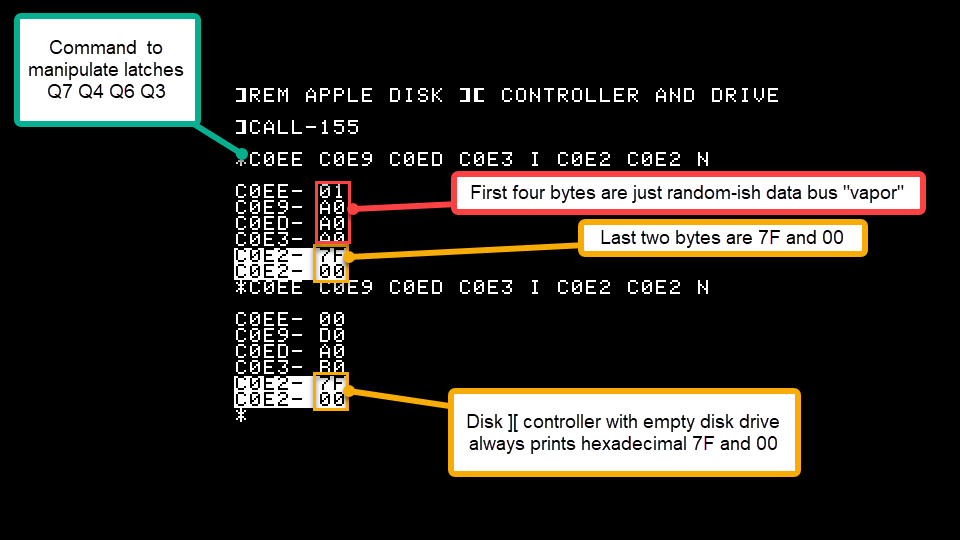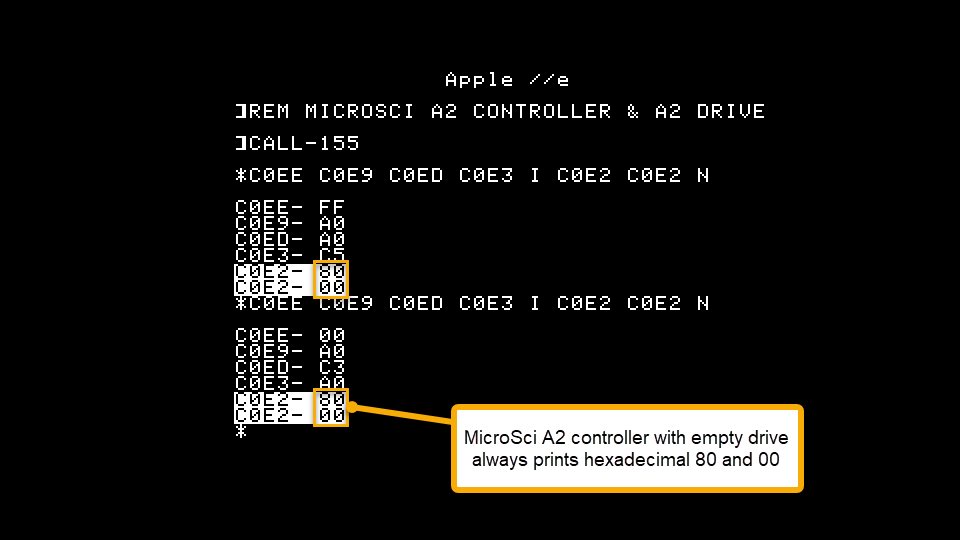Using the "Phi1 Echo" to distinguish disk controllers
Apple hid a quirky feature inside its disk drives: one of its head-positioning signals (Phi1) is deflected from the motor-control circuit board into the write-protect switch. I suppose they could have generated a TTL logic-level signal some other way, but it worked and that's the circuit they adopted. And Apple retained this eccentric wiring in their later Unidisk 5.25...which contributed to the headaches in designing the Yellowstone disk controller, as Steve wrote in a blogpost at Big Mess o' Wires: Circuit Sleuthing: Unidisk 5.25 Enable and PHI1.
As a side effect, the Disk ][ analog board is forced into write-protect mode any time Phi1 is enabled. That doesn't interfere with writing onto a disk for two major reasons:
- Phi1 corresponds to phase-1 of the stepper motor -- a guard band between tracks, not a recordable track
- All stepper phases are turned off before RWTS attempts to begin recording (which includes Phi1 naturally)
But it also provides a quirky way to distinguish the original Disk ][ controller from its TTL-based clones: by accessing switches Q7 Q4 Q6 Q1 to transmit a TTL logic-transition through Phi1 and listening forthe signal to echo back through the write-protect sense.
Let's construct a monitor command to do that:
*C0EE C0E9 C0ED C0E3 I C0E2 C0E2 N
Here's an explanation of each part of that command:
C0EEsets Q7 to low, disables accidental writing, and prints a random byte (ignore it)C0E9sets Q4 to high, sends an enable-signal to the drive, and prints a random byte (ignore it)C0EDsets Q6 to high, enables write-protect sensing, and prints a random byte (ignore it)C0E3sets Q1 to high, turns on Phi1, and prints a random byte (ignore it)Ienables "inverse" printing to help highlight the next bytes to be printedC0E2sets Q1 to low, turns off Phi1, and prints the contents of the data register (Disk II) or status register (any other controller)C0E2leaves Q1 at low, leaves Phi1 unchanged, and prints updated contents of the data register or status registerNenables "normal" printing again
Below is a screen capture of using that command with an original Apple Disk ][ controller with an empty disk drive attached. I typed the command twice to demonstrate that it printed the same results each time: in inverse, it printed the bytes 7F followed by 00.
That command gives different results if used with a different disk controller that doesn't duplicate the P6 ROM state-machine of the Disk II. For example, below is a screen capture of using that command with a Micro Sci's A2 controller, which replaces Wozniak's P6 ROM state-machine with TTL circuitry. The A2 controller printed the bytes 80 followed by 00.
I didn't test the IWM controller, employed in the Apple //c, because I don't have such a machine. But it should print another distinct pattern of bytes because it employs a status byte with an additional "drive enabled" status bit.
So an Apple //c would probably print the bytes A0 followed by 20. An Apple //c Plus would probably print AF followed by 2F because its mode register would be configured for a 3.5 drive by default.
Clones and derivatives that employ the same state machine as the Disk II controller should print the same results, such as Apple's later 5.25 IO Controller
- S.Elliott's blog
- Log in or register to post comments



Comments
FYI - Apple //c Plus displays
FYI - Apple //c Plus displays A0 A0
Aha, that's almost logical...
Ooo sure enough, that's almost-logical in hindsight. Very helpful!
Upon reflection, the //c Plus probably switches the IWM into 3.5 mode only while doing 3.5 IO, so it's logical that it would return A0 instead of
AF. Keeping the IWM in 5.25 mode by default would have been a sensible choice to ensure compatibility with software that bootedf from an external 5.25 drive.And the 3.5 drive uses Phi1 differently, so the "Phi1 echo" probably won't work like a 5.25 drive. But then I would have expected an empty 3.5 drive to display
20 20.Was the drive empty? Did there just happen to be a write-protected disk in the 3.5 drive?
Same with or without a disk
Same with or without a disk in the drive.